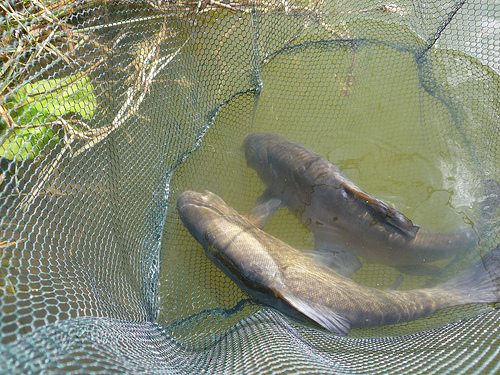Image Classification Batch Inference with PyTorch#

In this example, we will introduce how to use Ray Data for large-scale batch inference with multiple GPU workers.
In particular, we will:
Load the Imagenette dataset from an S3 bucket and create a Ray Dataset.
Load a pretrained ResNet model.
Use Ray Data to preprocess the dataset and do model inference parallelizing across multiple GPUs
Evaluate the predictions and save results to S3/local disk.
This example will still work even if you do not have GPUs available, but overall performance will be slower.
See this guide on batch inference for tips and troubleshooting when adapting this example to use your own model and dataset!
To run this example, you will need the following packages:
!pip install -q "ray[data]" torch torchvision
Step 1: Reading the Dataset from S3#
Imagenette is a subset of Imagenet with 10 classes. We have this dataset hosted publicly in an S3 bucket. Since we are only doing inference here, we load in just the validation split.
Here, we use ray.data.read_images to load the validation set from S3. Ray Data also supports reading from a variety of other datasources and formats.
import ray
import ray.data
s3_uri = "s3://anonymous@air-example-data-2/imagenette2/train/"
ds = ray.data.read_images(s3_uri, mode="RGB")
ds
2023-06-27 23:23:57,184 INFO worker.py:1452 -- Connecting to existing Ray cluster at address: 10.0.5.141:6379...
2023-06-27 23:23:57,228 INFO worker.py:1627 -- Connected to Ray cluster. View the dashboard at https://session-kncgqf3p7w2j7qcsnz2safl4tj.i.anyscaleuserdata-staging.com
2023-06-27 23:23:57,243 INFO packaging.py:347 -- Pushing file package 'gcs://_ray_pkg_32ef287a3a39e82021e70d2413880a69.zip' (4.49MiB) to Ray cluster...
2023-06-27 23:23:57,257 INFO packaging.py:360 -- Successfully pushed file package 'gcs://_ray_pkg_32ef287a3a39e82021e70d2413880a69.zip'.
2023-06-27 23:23:59,629 WARNING dataset.py:253 -- Important: Ray Data requires schemas for all datasets in Ray 2.5. This means that standalone Python objects are no longer supported. In addition, the default batch format is fixed to NumPy. To revert to legacy behavior temporarily, set the environment variable RAY_DATA_STRICT_MODE=0 on all cluster processes.
Learn more here: https://docs.ray.io/en/master/data/faq.html#migrating-to-strict-mode
Inspecting the schema, we can see that there is 1 column in the dataset containing the images stored as Numpy arrays.
ds.schema()
Column Type
------ ----
image numpy.ndarray(ndim=3, dtype=uint8)
Step 2: Inference on a single batch#
Next, we can do inference on a single batch of data, using a pre-trained ResNet152 model and following this PyTorch example.
Let’s get a batch of 10 from our dataset. Each image in the batch is represented as a Numpy array.
single_batch = ds.take_batch(10)
We can visualize 1 image from this batch.
from PIL import Image
img = Image.fromarray(single_batch["image"][0])
img.show()

Now, let’s download a pre-trained PyTorch Resnet model and get the required preprocessing transforms to preprocess the images prior to prediction.
import torch
from torchvision.models import ResNet152_Weights
from torchvision import transforms
from torchvision import models
weights = ResNet152_Weights.IMAGENET1K_V1
# Load the pretrained resnet model and move to GPU if one is available.
device = torch.device("cuda" if torch.cuda.is_available() else "cpu")
model = models.resnet152(weights=weights).to(device)
model.eval()
imagenet_transforms = weights.transforms
transform = transforms.Compose([transforms.ToTensor(), imagenet_transforms()])
Then, we apply the transforms to our batch of images and pass the batch to the model for inference, making sure to use the GPU device for inference.
We can see that most of the images in the batch have been correctly classified as “tench”, which is a type of fish.
transformed_batch = [transform(image) for image in single_batch["image"]]
with torch.inference_mode():
prediction_results = model(torch.stack(transformed_batch).to(device))
classes = prediction_results.argmax(dim=1).cpu()
del model # Free up GPU memory
labels = [weights.meta["categories"][i] for i in classes]
labels
['tench',
'tench',
'tench',
'tench',
'tench',
'tench',
'tench',
'tench',
'bittern',
'tench']
Step 3: Scaling up to the full Dataset with Ray Data#
By using Ray Data, we can apply the same logic in the previous section to scale up to the entire dataset, leveraging all the GPUs in our cluster.
Preprocessing#
First let’s convert the preprocessing code to Ray Data. We’ll package the preprocessing code within a preprocess_image function. This function should take only one argument, which is a dict that contains a single image in the dataset, represented as a numpy array. We use the same transform function that was defined above and store the transformed image in a new transformed_image field.
Note that typically, we would only want to keep the transformed image for efficiency purposes. However, for the sake of this tutorial, we are keeping the original image as well so that we can display them with the predictions at the end.
import numpy as np
from typing import Dict
def preprocess_image(row: Dict[str, np.ndarray]):
return {
"original_image": row["image"],
"transformed_image": transform(row["image"]),
}
Then we use the map() method to apply the function to the whole dataset row by row. We use this instead of map_batches() because the torchvision transforms must be applied one image at a time, due to the dataset containing images of different sizes.
By using Ray Data’s map() method, we can scale out the preprocessing to utilize all the resources in our Ray cluster.
“Note: the map() method is lazy. It won’t perform execution until we consume the results with methods like iter_batches() or take().”
transformed_ds = ds.map(preprocess_image)
2023-06-27 23:25:59,387 WARNING dataset.py:4384 -- The `map`, `flat_map`, and `filter` operations are unvectorized and can be very slow. If you're using a vectorized transformation, consider using `.map_batches()` instead.
Model Inference#
Next, let’s convert the model inference part. Compared with preprocessing, model inference has 2 differences:
Model loading and initialization is usually expensive.
Model inference can be optimized with hardware acceleration if we process data in batches. Using larger batches improves GPU utilization and the overall runtime of the inference job.
Thus, we convert the model inference code to the following ResnetModel class. In this class, we put the expensive model loading and initialization code in the __init__ constructor, which will run only once. And we put the model inference code in the __call__ method, which will be called for each batch.
The __call__ method takes a batch of data items, instead of a single one. In this case, the batch is a dict that has the "transformed_image" key populated by our preprocessing step, and the corresponding value is a Numpy array of images represented in np.ndarray format. We reuse the same inferencing logic from step 2.
from typing import Dict
import numpy as np
import torch
class ResnetModel:
def __init__(self):
self.weights = ResNet152_Weights.IMAGENET1K_V1
self.device = torch.device("cuda" if torch.cuda.is_available() else "cpu")
self.model = models.resnet152(weights=self.weights).to(self.device)
self.model.eval()
def __call__(self, batch: Dict[str, np.ndarray]):
# Convert the numpy array of images into a PyTorch tensor.
# Move the tensor batch to GPU if available.
torch_batch = torch.from_numpy(batch["transformed_image"]).to(self.device)
with torch.inference_mode():
prediction = self.model(torch_batch)
predicted_classes = prediction.argmax(dim=1).detach().cpu()
predicted_labels = [
self.weights.meta["categories"][i] for i in predicted_classes
]
return {
"predicted_label": predicted_labels,
"original_image": batch["original_image"],
}
Then we use the map_batches() API to apply the model to the whole dataset:
The first parameter of
map_batchesis the user-defined function (UDF), which can either be a function or a class. Because this case uses a class, the UDF runs as long-running Ray actors. For class-based UDFs, use theconcurrencyargument to specify the number of parallel actors.The
num_gpusargument specifies the number of GPUs needed for eachResnetModelinstance. In this case, we want 1 GPU for each model replica. If you are doing CPU inference, you can remove thenum_gpus=1.The
batch_sizeargument indicates the number of images in each batch. See the Ray dashboard for GPU memory usage to experiment with thebatch_sizewhen using your own model and dataset. You should aim to max out the batch size without running out of GPU memory. You may need to reduce this number to run this locally.
predictions = transformed_ds.map_batches(
ResnetModel,
compute=ray.data.ActorPoolStrategy(size=4), # Use 4 GPUs. Change this number based on the number of GPUs in your cluster.
num_gpus=1, # Specify 1 GPU per model replica.
batch_size=720, # Use the largest batch size that can fit on our GPUs.
)
Verify and Save Results#
Let’s take a small batch of predictions and verify the results.
prediction_batch = predictions.take_batch(5)
2023-06-27 23:26:04,893 INFO streaming_executor.py:91 -- Executing DAG InputDataBuffer[Input] -> TaskPoolMapOperator[ReadImage->Map] -> ActorPoolMapOperator[MapBatches(ResnetModel)]
2023-06-27 23:26:04,894 INFO streaming_executor.py:92 -- Execution config: ExecutionOptions(resource_limits=ExecutionResources(cpu=None, gpu=None, object_store_memory=None), locality_with_output=False, preserve_order=False, actor_locality_enabled=True, verbose_progress=False)
2023-06-27 23:26:04,895 INFO streaming_executor.py:94 -- Tip: For detailed progress reporting, run `ray.data.DataContext.get_current().execution_options.verbose_progress = True`
2023-06-27 23:26:04,950 INFO actor_pool_map_operator.py:114 -- MapBatches(ResnetModel): Waiting for 4 pool actors to start...
2023-06-27 23:26:29,120 INFO streaming_executor.py:149 -- Shutting down <StreamingExecutor(Thread-36, started daemon 140560158410496)>.
2023-06-27 23:26:29,335 WARNING actor_pool_map_operator.py:264 -- To ensure full parallelization across an actor pool of size 4, the specified batch size should be at most 360. Your configured batch size for this operator was 720.
We see that all the images are correctly classified as “tench”, which is a type of fish.
from PIL import Image
for image, prediction in zip(
prediction_batch["original_image"], prediction_batch["predicted_label"]
):
img = Image.fromarray(image)
display(img)
print("Prediction: ", prediction)

Label: tench

Label: tench

Label: tench

Label: tench

Label: tench
If the samples look good, we can proceed with saving the results to external storage (for example, local disk or cloud storage such as AWS S3). See the guide on saving data for all supported storage and file formats.
import tempfile
temp_dir = tempfile.mkdtemp()
# First, drop the original images to avoid them being saved as part of the predictions.
# Then, write the predictions in parquet format to a path with the `local://` prefix
# to make sure all results get written on the head node.
predictions.drop_columns(["original_image"]).write_parquet(f"local://{temp_dir}")
print(f"Predictions saved to `{temp_dir}`!")
2023-06-27 23:26:38,105 INFO streaming_executor.py:91 -- Executing DAG InputDataBuffer[Input] -> TaskPoolMapOperator[ReadImage->Map] -> ActorPoolMapOperator[MapBatches(ResnetModel)] -> TaskPoolMapOperator[MapBatches(<lambda>)] -> TaskPoolMapOperator[Write]
2023-06-27 23:26:38,106 INFO streaming_executor.py:92 -- Execution config: ExecutionOptions(resource_limits=ExecutionResources(cpu=None, gpu=None, object_store_memory=None), locality_with_output=False, preserve_order=False, actor_locality_enabled=True, verbose_progress=False)
2023-06-27 23:26:38,106 INFO streaming_executor.py:94 -- Tip: For detailed progress reporting, run `ray.data.DataContext.get_current().execution_options.verbose_progress = True`
2023-06-27 23:26:38,141 INFO actor_pool_map_operator.py:114 -- MapBatches(ResnetModel): Waiting for 4 pool actors to start...
2023-06-27 23:27:27,855 INFO streaming_executor.py:149 -- Shutting down <StreamingExecutor(Thread-74, stopped daemon 140560149755648)>.
Predictions saved to `/tmp/tmp0y52g_f5`!